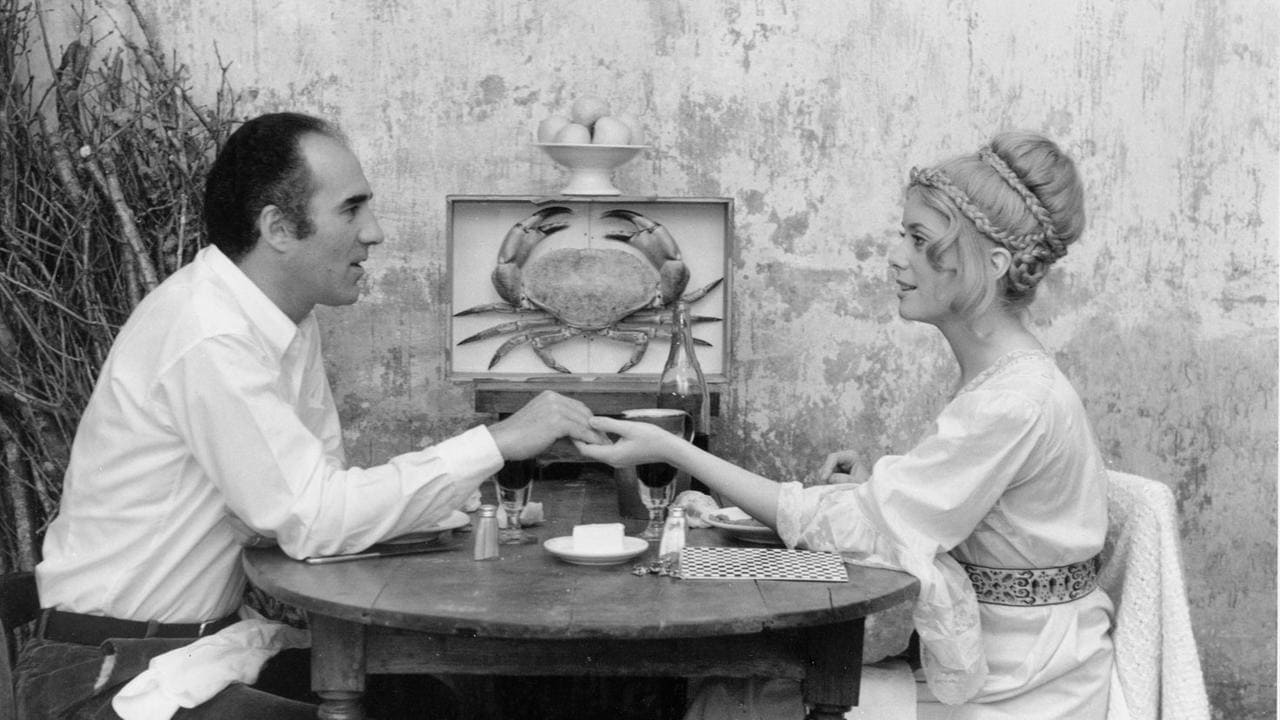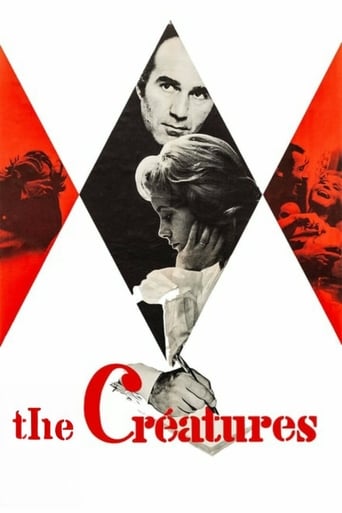

In this totally senseless pseudo-sci-fi film, Catherine Deveuve is mute for 95% of the time; as if to compensate, her husband Michel Piccoli (playing a character named Piccoli - how profound) can talk to animals! Shot in black-and-white, the film uses a red monochrome every time someone does something weird - which happens a lot. It also has an incessantly piercing violin score. One of those art films which drive people away from art films. 0.5 out of 4 stars.
... View MoreWith Christmas coming up,I started searching round for a French New- Wave (FNW) title that I could give a friend as an X-Mas gift.Talking to a DVD seller,I was happy to learn that he had recently tracked down a near-forgotten FNW title starring Catherine Deneuve,which led to me getting ready to discover what creatures lay inside the zoo.The plot:Driving with his wife Mylène Piccoli, Edgar takes a wrong turn and crashes his car,which leads to Mylène becoming a mute.Weeks later:Desperate to complete the writing of his Sci-Fi novel (which is about an evil mastermind,who secretly drops metallic discs into peoples pockets,in order to control them),Edgar decides to put his free-wheeling life behind,and to instead put his head down and spend most of the time writing the book,and spending time with Mylène (who due to still being mute writes on boards.)Talking to Mylène,Edgar is given the excellent news that she is pregnant.Attempting to relax from his writing,Edgar decides to take long walks around the near-by town.Due to it being a small island where everyone knows everything,the locals start to think that some is wrong with Edgar,due to how little he talks to any of them.Running into a number of locals, (from petty thieves to shop owners) Edgar finds his anger to boil over,which leads to most of the towns residence viewing him as a weirdo.Spotting a strange tower on the outskirts of the town,Edgar arranges 2 local thieves to sneak him in,which leads to Edgar discover that the mysterious resident of the tower is playing a rather peculiar game of chess.View on film:Whist she has hardly any lines of dialogue,the gorgeous Catherine Deneuve gives an exquisite performance as Mylène,thanks to Deneuve showing the psychological effect that Edgar's behaviour has had on Mylène,with Deneuve give Mylène a stoic face,which reveals the lack of emotion that she is receiving from Edgar.Entering the movie as a right playboy, Michel Piccoli gives a superb,rather subtle performance as Edgar,whose self-centred edges soften,as Piccoli shows the weight of Edgar's chess game with the mysterious stranger to slowly sink in.Being one of the few women directors of the FNW,writer/director Agnès Varda shows that she can proudly stand her own ground against any guys of the FNW.Giving the film a rustic documentary quality via B&W footage of the towns shipping yard and shops.Allowing the viewer to sink into the B&W,Varda suddenly turns the film upside down,by brilliantly splashing the film with red,which along with expressing Edgar's boiling emotions,also gives the title an ultra- stylised chess motif,as Edgar finds out that there are people who he can't check-mate.
... View More..the others will think it merely arty.Like so many nouvelle vague artists,Agnès Varda tries hard here to say something "deep" "meaningful" and "of consequence".All Varda's qualities seem to have vanished into thin air:spontaneity,simplicity and sensitiveness,which made her beautiful "Cleo de 5 à 7" so worthwhile and so new at the beginning of the sixties.These qualities seemed to remain in the follow-up "le bonheur",but this latter work is rather unpleasant in several respects.(Mrs Alice Liddell wrote a very good IMDb comment for "le bonheur",read it and you'll know what I mean)In "les creatures" Varda casts Piccoli as a writer and Deneuve his mute (because of an accident)wife .The other characters are all pawns in a giant chess game.Sometimes the screen turns red ,maybe to indicate that it's not the same "player",who knows?Actually this is the kind of movie which defies analysis.It was the eighties before Agnès Varda was again in clover with "sans toit ni loi" and "Jacquot de Nantes".
... View More"When one has much to put in them, a day has a hundred pockets." NietzscheIn the first few reels of this film, quite a number of things were slipped into the pockets of different people. What they were, and into whose pockets and by whom they were slipped was not always readily apparent. If it had been, my mind might not have drifted into default mode and thought of the Nietzsche quote - which quote may or may not have influenced Agnes Varda. Perhaps she just liked pockets. Pockets can be decorative and they can reveal as well as conceal. And what deeper convoluted pockets than those of the mind?The film begins with a couple travelling in a sports car - she implores him to go slower. His response, predating that of a popular American actor yet to be born, could be synopsized as: "I feel the need for speed." The stimulation, the rush, the kinetic excitement of rapid movement . . . this feeds his artistic temperament. She still wishes him to slow down - or at least be more careful. The camera slowly pulls up from the plane of movement of the car, which is travelling by the seaside, until the car disappears and we hear the inevitable crash.The rest of the film takes place on an island. The man seems to have adapted to the thoughts of Raymond Inmay on creativity: "If you are seeking creative ideas, go out walking. Angels whisper to a man when he goes for a walk." While this may be true, some islanders see his walking as suspicious.For a writer - and a filmmaker, I imagine, everything in life can become grist for the artistic/creative mill. One well-known actor once told Fellini how he interpreted one of his movies and asked him: "Am I right? Is that what you meant?" To which Fellini responded: "If that's what you saw in it, that's what I meant." While I have some ideas about what the pockets could mean, I have very few about the sea crabs, whose imagery was also rather abundant. If you're on an island, you're going to see ocean life. But there were a lot of crabs, both dead and alive, and a mechanical claw device, used in concert with a live-action "chess" game toward the end of the film.What is actually going on in this film? Well, besides Nietzsche, you might want to keep a line from Gilbert & Sullivan on hand - HMS Pinafore, Act II (1878) "Things are seldom what they seem/ Skim milk masquerades as cream" Perhaps 1/2 hour into the film, the cinematography gives a pretty good clue that there is more than a singular reality operating here - and things pretty much flow from there to the film's conclusion.And what does Mr. Ed have to do with anything? Well, I don't recall any non-cartoon talking rabbits in pre-1965 cinema (although I'm not saying definitively there *weren't* any). But there was a talking horse who won a Golden Globe award in 1963. Was Agnes Varda a Mr. Ed fan? I know not. Regardless, the talking horse and talking bunny sequence were nice lightening touches in the film. Another was the "in-joke" (if you know Varda's filmography) of two guys trying to crack a safe - and they get inspiration for 2 of the numbers from Varda's CLEO FROM 5 TO 7.So - what kind of creatures are we, anyway? Are we the masters of our universe? And, if we are a writer - are we even the master of the characters we invent? More than one writer has reported characters in a work of fiction taking on a life of their own - becoming unruly, even. And if a writer has difficulty controlling his own "creatures," how much control do the writer's "creatures" have over their own destiny?How much do *we* have over ours? Or over that of others?This question is perhaps best amplified by the live-action "chess" game toward the end of the film. Even the best of intentions can have unexpected results. Just a minor change in circumstances can have a cascading effect (Kieslowski's BLIND CHANCE, 1982; Howitt's SLIDING DOORS, 1998)These are a few of the thoughts, loosely stuffed in available pockets, that washed over me in the watching of the film. I was also reminded of Jonathan Carroll's first novel, THE LAND OF LAUGHS about writers and their creations. Check it out - it might even make it to the screen some day.
... View More